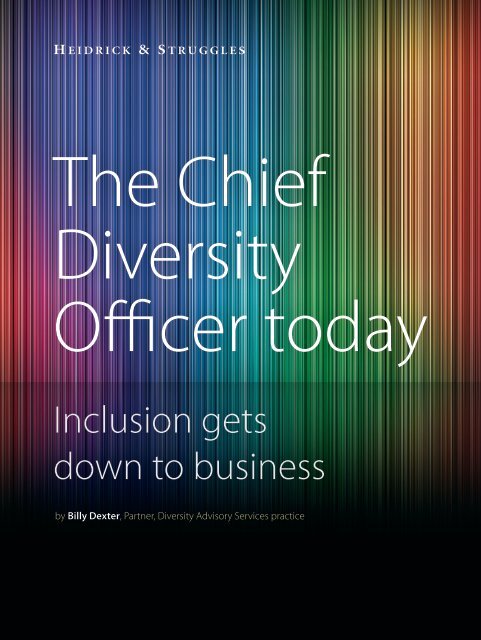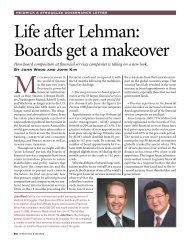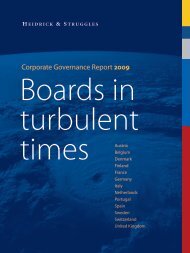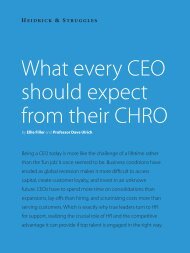The Chief Diversity Officer today - Heidrick & Struggles
The Chief Diversity Officer today - Heidrick & Struggles
The Chief Diversity Officer today - Heidrick & Struggles
You also want an ePaper? Increase the reach of your titles
YUMPU automatically turns print PDFs into web optimized ePapers that Google loves.
<strong>The</strong> <strong>Chief</strong><br />
<strong>Diversity</strong><br />
<strong>Officer</strong> <strong>today</strong><br />
Inclusion gets<br />
down to business<br />
by Billy Dexter, Partner, <strong>Diversity</strong> Advisory Services practice
From roots in compliance<br />
and equal opportunity,<br />
diversity has emerged as<br />
a critical business issue for<br />
leading companies. <strong>The</strong>y<br />
are aggressively seeking to<br />
harness its business relevancy<br />
by creating a culture of<br />
inclusion where the diversity<br />
of ideas shows up in better<br />
performance. To lead this<br />
enterprise-wide change they<br />
are elevating the role of <strong>Chief</strong><br />
<strong>Diversity</strong> <strong>Officer</strong> and seeking<br />
to fill it with people who have<br />
the requisite competencies to<br />
meet its unique – and often<br />
misunderstood – challenges.<br />
2 <strong>The</strong> <strong>Chief</strong> <strong>Diversity</strong> <strong>Officer</strong> <strong>today</strong>: Inclusion gets down to business<br />
A recent analysis by <strong>Heidrick</strong> & <strong>Struggles</strong> of the role of<br />
diversity executives among Fortune 500 companies<br />
turned up some intriguing results. Of the 490 companies<br />
analyzed, 307 have an executive role designated for<br />
diversity. Strikingly, the higher a company ranks on the<br />
Fortune list, the more likely it is to have a diversity officer.<br />
For example, 81 of the top 100 companies have diversity<br />
officers, while only 46 of the bottom 100 have such a role<br />
(figure 1). Moreover, the higher a company ranks on the<br />
list, the more importance it is likely to accord the role,<br />
designating its occupant <strong>Chief</strong> <strong>Diversity</strong> <strong>Officer</strong> (CDO) or<br />
the equivalent.<br />
A number of trends that have been developing for three<br />
decades or more are converging in 2010 to significantly<br />
elevate the importance of diversity to these companies:<br />
a growing recognition of the business value of diversity,<br />
its importance for innovation, and its role in creating<br />
a vibrant and productive company culture. For many<br />
organizations the tipping point has come with the<br />
realization that success in global markets and increasingly<br />
diverse domestic markets requires diverse leadership.<br />
A report of the Census Bureau in May of 2008 sharply<br />
focused attention on the changing demographics of the<br />
US market. <strong>The</strong> Bureau found that more than one-third<br />
(34%) of the US population consists of people who identify<br />
themselves as being of ‘minority’ racial or ethnic heritage,<br />
an increase of 11% from 2000. From July 2006 to July 2007,<br />
the Hispanic population grew by 3.3%, followed by Asians<br />
at 2.9%, blacks at 1.3%, native Hawaiians and other Pacific<br />
islanders by 1.6%, and American Indians and Alaska natives<br />
by 1%. At the same time, the white population grew by<br />
only 0.3%. <strong>The</strong> approximately 45.5 million Hispanics living<br />
in the United States are now the country’s largest minority<br />
group, accounting for 15% of the population, followed<br />
by blacks at 40.7 million (13.5%), and Asians at 15.2 million<br />
(5%). Four states and the District of Columbia are “majorityminority,”<br />
with more than 50% of their populations made<br />
up of people other than single-race non-Hispanic whites.<br />
Hawaii led the nation with a population that was 75%<br />
minority in 2007, followed by the District of Columbia<br />
(68%), New Mexico (58%), California (57%) and Texas<br />
(52%). This growth in minority populations means not only<br />
increasingly diverse markets, but also increasingly diverse<br />
new entrants into the workforce.
100<br />
80<br />
60<br />
40<br />
20<br />
0<br />
figure 1<br />
92<br />
74<br />
62<br />
<strong>Diversity</strong> analysis for the Fortune 500 companies<br />
base: 490 companies source: <strong>Heidrick</strong> & <strong>Struggles</strong> KMC research, 2009<br />
Further, in 2008 the United States elected its first African-<br />
American President, a development that was greeted<br />
enthusiastically by diverse populations around the globe.<br />
<strong>The</strong> new administration has created the most diverse and<br />
inclusive leadership team in the country’s history, setting a<br />
new standard for all organizations.<br />
Meanwhile, the most promising emerging markets are no<br />
longer the largely white Eastern European countries and<br />
similar regions, but China, India, Brazil, and a number of<br />
countries in Africa. <strong>The</strong> economies of developing countries<br />
are expected to provide the most powerful engine of<br />
global growth for the foreseeable future, outstripping<br />
global growth as a whole, even if developed countries<br />
recover completely in 2010.<br />
<strong>Diversity</strong> is no longer merely an issue of equity in hiring<br />
but of strategy in the marketplace. Companies that are<br />
unable to communicate with or win over diverse markets<br />
domestically and globally will see their market share erode<br />
and their financial performance suffer. Leading companies<br />
that understand these dynamics have accordingly evolved<br />
the role of diversity officer from its earlier incarnations in<br />
equal opportunity and compliance to that of a change<br />
agent. In this demanding new role, the diversity officer<br />
must be able to help guide the company through major<br />
cultural transformation in order to harness the business<br />
value of diversity as a core competence of the company.<br />
51 46<br />
1-100 101-200 201-300 301-400 401-500<br />
<strong>The</strong> evolution<br />
of the role<br />
From the mid 1980s to the late 1990s, the role of diversity<br />
officer, director, or manager lacked positive connotations<br />
in the business world and offered no career path. It was<br />
often an obscure role far down in the HR organization<br />
or otherwise occupied some anomalous and essentially<br />
powerless position on the org chart. Some organizations<br />
put people into the diversity role who had no previous<br />
experience, or people whose careers were in decline, or<br />
someone who happened to be a visible minority with<br />
a passion for diversity. Often, they were placed in an<br />
affirmative action or EEO role. <strong>Diversity</strong> strategies were<br />
not tied to business results and diversity professionals<br />
were not expected to be strategic business partners or<br />
demonstrate strong business acumen.<br />
However, as leading companies realized the business<br />
relevancy of diversity and inclusion, their stance gradually<br />
changed. Those who early on saw the demographic<br />
writing on the wall understood that their workforce should<br />
look like their customer base, not only out of fairness but<br />
because they believed that from a brand perspective such<br />
policies might improve business results. Eventually, some<br />
began to see that diversity wasn’t simply a numbers game<br />
<strong>Heidrick</strong> & <strong>Struggles</strong> 3
ut a matter of bringing diverse ideas and perspectives<br />
into the company in such areas as marketing, product<br />
development, and the like. Today, the leaders in diversity<br />
have taken it several steps further. <strong>The</strong>y value diversity of<br />
perspectives and know how to put it to work in a business<br />
context. But they also know that to secure long-term<br />
advantage from diversity they must create a corporate<br />
culture where diversity is central to strategy as well as to<br />
operations.<br />
Over the course of this evolution, companies have put<br />
resources into an ever-widening circle of activities.<br />
<strong>Diversity</strong> and inclusion training has been adopted so<br />
that employees can bring their ‘whole selves’ to work,<br />
where everyone has an opportunity to be successful and<br />
thereby add business value. Much effort has also been put<br />
into talent acquisition and retention in order to recruit a<br />
diverse workforce at all levels, improve the ‘employment<br />
brand,’ and to increase the likelihood of keeping the most<br />
valuable of those employees.<br />
In many cases, diversity efforts haven’t stopped at the four<br />
walls of the company but have been extended to include<br />
the company’s expenditures with minority or otherwise<br />
diverse suppliers and vendors. In fact, such expenditure<br />
is one of the four measures that <strong>Diversity</strong>Inc magazine<br />
applies in its annual scorecard of the top 50 companies<br />
for diversity – the other three being CEO commitment,<br />
human capital, and corporate and organizational<br />
communications. More recently, effort has gone into tying<br />
diversity to business performance through such measures<br />
as increased revenues, market penetration, and employee<br />
retention.<br />
As the business importance of diversity has increased,<br />
so has the role of the diversity officer. In some leading<br />
US companies the <strong>Chief</strong> <strong>Diversity</strong> <strong>Officer</strong> has a direct<br />
line to the C-suite, and in some cases, a direct line to the<br />
CEO. In these companies, the CDO isn’t seen as merely a<br />
provider of ‘diversity services’ to other functions or as an<br />
adjunct to HR but as a critical player in orchestrating the<br />
change that will lead to a new business culture. To get it<br />
right, companies must not only do the relatively easy job<br />
of recognizing the value of the role, but also the much<br />
harder job of finding or developing a CDO who has the<br />
competencies to succeed in it.<br />
4 <strong>The</strong> <strong>Chief</strong> <strong>Diversity</strong> <strong>Officer</strong> <strong>today</strong>: Inclusion gets down to business<br />
Essential<br />
competencies for<br />
<strong>Chief</strong> <strong>Diversity</strong> <strong>Officer</strong>s<br />
Based on our firm’s leadership research and our experience<br />
working with companies on talent issues related to<br />
diversity, we have found that <strong>today</strong>’s successful CDO<br />
has seven essential competencies – the observable<br />
skills, knowledge, and abilities that are required for<br />
high performance within a given role. Those seven<br />
competencies include:<br />
• Business acumen: <strong>The</strong> CDO must know the company’s<br />
business and have a keen sense of business judgment.<br />
<strong>The</strong> best among <strong>today</strong>’s CDOs are able to create<br />
diversity strategies tied to company strategy and to<br />
measure the impact of diversity on the business.<br />
• Leadership: As a leader, the CDO establishes a clear<br />
vision for diversity and communicates it throughout<br />
the organization. <strong>The</strong> vision states where the<br />
organization needs to go and the CDO maps out how<br />
the company will get there.<br />
• Change management: <strong>The</strong> CDO is able to<br />
systematically orchestrate and drive culture change<br />
throughout the organization. <strong>The</strong> ultimate goal is to<br />
create a culture in which the extraction of business<br />
value from diversity is second nature at all levels of the<br />
organization.<br />
• Results orientation: As a change agent and business<br />
leader, the CDO establishes metrics for change and<br />
has the ability to move the organization from point to<br />
point and in clear alignment with business results.<br />
• Building and maintaining credibility: Because CDOs<br />
cross so many different business lines, they must be<br />
able to build and maintain credibility with a variety of<br />
different constituencies both internally and externally.<br />
If the CDO is unable to build strategic partnerships<br />
with these stakeholders, diversity initiatives are likely<br />
to wither on the vine.<br />
• Ability to influence: <strong>Diversity</strong> has many aspects that<br />
are often difficult to articulate and to create buy-in<br />
around. <strong>The</strong> CDO must have the ability to persuade<br />
other leaders of the value and the many implications of
diversity – keeping in mind that many of those leaders<br />
will be at different levels of understanding of what’s at<br />
stake.<br />
• Commitment to diversity: Certainly, the CDO should<br />
be committed to diversity both as a value in its own<br />
right and as an engine of better business performance.<br />
That commitment includes maintaining expertise<br />
in the full spectrum of diversity, from cross-cultural<br />
sensitivity to the ability to define what constitutes an<br />
inclusive workforce, to the ability to make diversity a<br />
concrete reality in the business.<br />
In assessing potential CDOs, it is essential that none of<br />
these competencies be overlooked. Results orientation<br />
in the absence of the ability to influence others and<br />
maintain credibility will produce little in the way of results.<br />
Similarly, commitment without change management<br />
or leadership skills is unlikely to make a difference in an<br />
organization. Today’s complete CDO possesses all of these<br />
competencies in exceptional measure and puts them to<br />
work every day.<br />
office business focus CDO’s role<br />
<strong>Chief</strong> Executive <strong>Officer</strong><br />
/ Board of Directors<br />
figure 2<br />
CDO – C-Suite relationships<br />
How the diversity leader interacts with senior leaders<br />
source: <strong>Diversity</strong> Best Practices<br />
Chairing new Board governance efforts,<br />
increasing Shareholder value in the midst of<br />
regulatory reform and economic uncertainty<br />
<strong>Chief</strong> Marketing <strong>Officer</strong> New entry into US and Global Multicultural<br />
markets<br />
<strong>Chief</strong> Ethics <strong>Officer</strong> Sarbanes Oxley, SEC and other regulatory reform<br />
matters<br />
<strong>Chief</strong> Legal <strong>Officer</strong> EEO, Sarbanes Oxley, SEC and industry related<br />
regulatory issues<br />
<strong>Chief</strong> Information<br />
<strong>Officer</strong><br />
Supply Chain Management; Knowledge<br />
Management – enabling virtual communications<br />
and connectivity<br />
<strong>The</strong> CDO as Strategic<br />
Business Partner<br />
Much of the need for these competencies comes down to<br />
an inescapable fact: almost all of the policies, initiatives,<br />
and strategies that come under the heading of diversity<br />
usually depend on others for execution – others over<br />
whom the CDO may have no operational authority. As<br />
a result, much of the operating responsibility of the role<br />
involves providing consulting and coaching to senior<br />
executives about diversity – helping them develop<br />
strategy for their business units and making sure that they<br />
understand what the organization is doing and why, how<br />
results are measured, who is accountable. From a strategic<br />
point of view, the CDO must not only be able to interact<br />
effectively with others on the executive team but also play<br />
a wide variety of roles in providing value that these other<br />
leaders will be eager to embrace and to put into practice<br />
(figure 2).<br />
Supports the CEO in influencing organizational<br />
change<br />
Instilling multicultural competencies within the<br />
organization to enable innovative strategies which<br />
accelerate new market entry<br />
CDO may have Ethics role in establishing the<br />
guidelines for the corporate code of conduct<br />
Aligning accountability with legal and governance<br />
policies<br />
Leveraging the organizations infrastructure to<br />
connect people to each other<br />
<strong>Chief</strong> Financial <strong>Officer</strong> Sarbanes Oxley, SEC and Investor Relations efforts Creating a value proposition optimizing<br />
opportunities, minimize risk and maximizing returns<br />
<strong>Chief</strong> Communications<br />
<strong>Officer</strong><br />
<strong>Chief</strong> Human Resources<br />
<strong>Officer</strong><br />
Implement communication strategy and align<br />
enterprise wide<br />
Alignment of strategy, structure and systems<br />
so it is in the employee’s self-interest to work<br />
inclusively and productively<br />
Internal and external positioning of the company,<br />
its <strong>Diversity</strong> brand attributes and community<br />
involvement<br />
Pipeline development, succession planning, bonus<br />
systems, professional development, training and<br />
programs, i.e. mentoring, affinity groups, recognition<br />
events<br />
<strong>Heidrick</strong> & <strong>Struggles</strong> 5
<strong>The</strong> strategic scope of the role has increasingly meant<br />
working closely with the CEO and interacting with the<br />
Board. In the past, Board presentations from diversity<br />
officers were rare. Today, however, CDOs in leading<br />
companies appear before their Boards to assure them<br />
that the organization has satisfied legal concerns<br />
and is creating an inclusive culture by aligning talent<br />
management strategies. And because savvy Boards<br />
understand that embracing diversity and diverse teams<br />
leads to smarter decisions, they want to make sure<br />
that senior leadership in the organization is embracing<br />
diversity and inclusion, to know how diversity is being<br />
integrated into key business decisions, and to understand<br />
how diversity is impacting shareholder value.<br />
<strong>The</strong> scope of the strategic role also includes complex<br />
global components as the company operates in different<br />
cultures around the world, where diversity means different<br />
things to different people. In many European countries<br />
diversity is regarded less as an issue of ethnicity and more<br />
of an issue of gender and social class. Further, it is often<br />
positioned as a matter of equal opportunity. Although<br />
the business impact of diversity is often recognized, the<br />
business case for comprehensively pursuing it is a fairly<br />
new concept. For companies operating internationally, it<br />
is therefore essential to have a CDO who understands the<br />
challenges in differing locales and can develop a strategy<br />
that is appropriate for each and orchestrate them in the<br />
overall culture of the company.<br />
figure 3<br />
Logistics<br />
Technology<br />
Financial Services<br />
Business & Professional Services<br />
Life Sciences<br />
Consumer<br />
Industrial<br />
<strong>The</strong> best sectors for diversity in Fortune 500 companies<br />
source: <strong>Heidrick</strong> & <strong>Struggles</strong> KMC research, 2009<br />
4<br />
39<br />
74<br />
12<br />
30<br />
115<br />
216<br />
6 <strong>The</strong> <strong>Chief</strong> <strong>Diversity</strong> <strong>Officer</strong> <strong>today</strong>: Inclusion gets down to business<br />
Finding the right<br />
<strong>Chief</strong> <strong>Diversity</strong> <strong>Officer</strong><br />
<strong>The</strong> executives who are taking on the exacting challenges<br />
of diversity at leading companies <strong>today</strong> are themselves a<br />
diverse lot. Our analysis of the Fortune 500 found that 65%<br />
of diversity officers are female. In terms of ethnicity, 37%<br />
are African-American, 19% Caucasian, 4% Hispanic, 2%<br />
Asian, and 39% unknown. <strong>The</strong>ir educational backgrounds<br />
are varied, ranging from to MBAs to JDs, to undergraduate<br />
and graduate degrees in a wide range of disciplines. Of<br />
a sample of 182 diversity officers, the terminal degree for<br />
73 is a bachelor’s, for 87 it is a master’s, and for 22 it is a<br />
doctorate. Interestingly, there is little disparity between<br />
the percentage of these diversity officers developed<br />
internally versus those hired externally. In a sample of 205,<br />
we found that 54% were internal appointees and 46%<br />
were external hires.<br />
To determine the industrial sectors in which the efforts of<br />
these executives are meeting with the most success we<br />
used a proprietary <strong>Heidrick</strong> & <strong>Struggles</strong> assessment system<br />
to grade companies. Each company was assessed across<br />
five criteria on a scale of 1 to 5, with 1 being poor and 5<br />
being outstanding. Overall, the companies on the Fortune<br />
500 achieved an average score of 2.84. By sector, the top<br />
performer was Logistics (figure 3). Although the sample<br />
number of<br />
companies average rating score<br />
2.74<br />
2.61<br />
3.24<br />
3.2<br />
3.14<br />
3.1<br />
3.5
for this sector was small, the logistics companies on the<br />
Fortune list have long been in the forefront of diversity<br />
efforts. Technology was the second best performer at 3.21,<br />
followed closely by Financial Services at 3.18. Somewhat<br />
surprisingly, the Consumer sector, for which diverse<br />
markets on a large scale are critical, scored only 2.74.<br />
In our experience, successful integration of diversity into<br />
the business for the companies that constitute these<br />
sectors requires three things:<br />
• Board and CEO commitment to diversity and inclusion.<br />
• Senior leadership’s understanding of diversity as<br />
central to the business.<br />
• A CDO who possesses the requisite competencies that<br />
the new prominence of the role demands.<br />
Boards and CEOs increasingly ‘get it’ when it comes to<br />
diversity. And in leading companies senior leadership<br />
understands the business value of diversity. In addition,<br />
as we have found in our research, these companies<br />
are developing a cadre of leading diversity executives.<br />
However, as more companies scramble to catch up to the<br />
leaders in their sectors, demand for top diversity talent is<br />
increasing sharply and the talent pool is limited. Because<br />
About the author<br />
Billy Dexter is a Partner at <strong>Heidrick</strong> & <strong>Struggles</strong> and is a<br />
member of the global <strong>Diversity</strong> Advisory Services practice<br />
that assists clients in creating diverse leadership teams.<br />
Prior to joining <strong>Heidrick</strong> & <strong>Struggles</strong>, he was Executive<br />
Vice President & <strong>Chief</strong> <strong>Diversity</strong> <strong>Officer</strong> at Viacom MTV<br />
Networks and former CDO at the Hudson Highland Group.<br />
+1 312 496 1720<br />
bdexter@heidrick.com<br />
the centrality of diversity to business has been recognized<br />
only relatively recently, there are few top executives<br />
with the enterprise-wide, global experience that the role<br />
demands. Further, the ability to lead and orchestrate<br />
cultural change on the scale that <strong>today</strong>’s CDO must tackle,<br />
requires individuals who possess all of the requisite<br />
competencies to an unusually high degree.<br />
To help find and attract such talent, many leading<br />
companies turn to <strong>Heidrick</strong> & <strong>Struggles</strong>. Our <strong>Diversity</strong><br />
Advisory Services practice assesses and maps top diversity<br />
talent and maintains relationships with that talent around<br />
the globe.<br />
Whether under the title CDO or something else, this<br />
new breed of diversity and inclusion leaders knows<br />
how to harness the business value of diversity as a core<br />
competence of the company. Working with <strong>Heidrick</strong><br />
& <strong>Struggles</strong> to find or develop this much-in-demand<br />
talent, companies can make strides that continue to<br />
pay dividends over the long term – in market share,<br />
product innovation, productivity, acquisitions, leadership<br />
effectiveness and the many other areas where diversity<br />
and inclusion get down to business. <br />
<strong>Heidrick</strong> & <strong>Struggles</strong> 7
<strong>Heidrick</strong> & <strong>Struggles</strong> is the leadership advisory firm<br />
providing senior-level executive search and leadership<br />
consulting services, including succession planning,<br />
executive assessment, talent retention management,<br />
executive development, transition consulting for newly<br />
appointed executives, and M&A human capital integration<br />
consulting. For almost 60 years, we have focused on<br />
quality service and built strong leadership teams through<br />
our relationships with clients and individuals worldwide.<br />
Today, <strong>Heidrick</strong> & <strong>Struggles</strong>’ leadership experts operate<br />
from principal business centers in North America, Latin<br />
America, Asia Pacific and Europe, Middle East & Africa.<br />
For more information about <strong>Heidrick</strong> & <strong>Struggles</strong>,<br />
please visit www.heidrick.com<br />
Copyright ©2010 <strong>Heidrick</strong> & <strong>Struggles</strong> International, Inc.<br />
All rights reserved. Reproduction without permission is prohibited.<br />
Trademarks and logos are copyrights of their respective owners.<br />
201001JNTSRG42
















